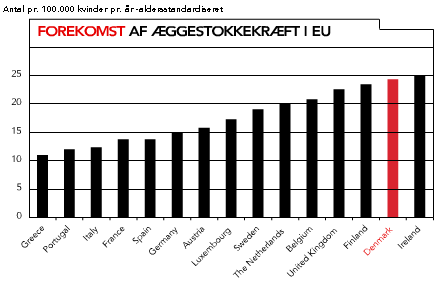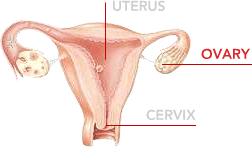OVARIAN CANCER

Denmark has the highest rate of mortality in the world
Ovarian cancer is together with uterine cancer the most common type of gynaecological cancer in Denmark with a little more than 600 new cases a year. Unfortunately, Denmark has the highest rate of mortality in the world.
Around 20% of the cases are seen with younger women before the menopause, and approximately 80% are seen after the menopause. The life time risk of developing ovarian cancer is set to 2% in Denmark. The causes of ovarian cancer are said to be many, and in most cases any one cause cannot be stated. Research has, however, pointed at a few factors which may predispose to or protect against the development of cancer.
If a woman has never given birth, her risk is increased by a factor 2. If a woman has not been able to become pregnant (is infertile), the risk is bigger. At the same time, the number of years with ovulation (menstruation) seems to increase the risk of developing cancer. If the woman has had a lesser number of ovulations by either taking contraceptive pills, being pregnant or breast-feeding, the risk of developing ovarian cancer is reduced by up to 50%.
Based on our current knowledge, approximately 10% of the cancer incidents are thought to be hereditary.
By the breast-ovarian cancer-syndrome, one or more changes in the BRCA1 and BRCA2 genes are seen. By changes in these genes, the risk of both breast and ovarian cancer is increased by 50-90%, dependant on which changes have arisen.
 Today, there is no screening against ovarian cancer.
Today, there is no screening against ovarian cancer.
The female pelvis is built to be able to contain a pregnant uterus with as few problems as possible for the woman. Unfortunately, that also means that a tumor on the ovaries can develop quite significantly before any symptoms are felt. Often, the woman does not become aware of her womb, until the size of her abdomen is such that her clothes no longer fit.
This can be caused by an accumulation of fluid in the abdominal cavity and unfortunately often implies an advanced type of cancer.
You can have a blood test taken, CA 125, which may be increased by ovarian cancer. Together with an ultrasound scan of the pelvis, the blood test is used to state the risk of the presence of a cancer tumor.
The most important treatment of ovarian cancer is the surgical procedure of removing as much tissue from the tumor as possible. Most women will afterwards be offered chemo therapy every third to fourth week over six months. Survival is dependant on the stage of the disease at the time of diagnosis. More aggressive surgical techniques and improved chemo therapy has increased the mean survival time after the time of diagnosis from approx. one year in the 1970s, approx. two years in the 1980s to approx. three years in the 1990s.
Only marginal improvements in the survival rate can be achieved by improving the surgical techniques and improving chemo therapeutica. Continued intensive research is necessary if the prognosis for this type of cancer is to be significantly improved. A mapping of the gene modifications in cancer patients is one way, but a major research task is pending if better results are to be achieved.
Read more about ovarian cancer on
www.cancer.dk and www.ovariancancer.org
Read more about Uterine cancer Read more about Cervical cancer